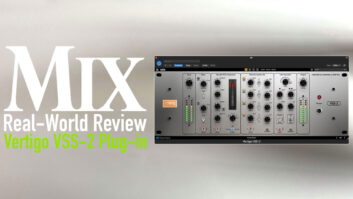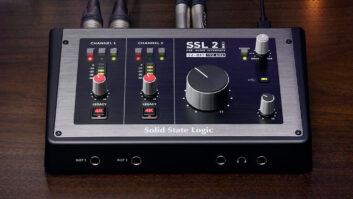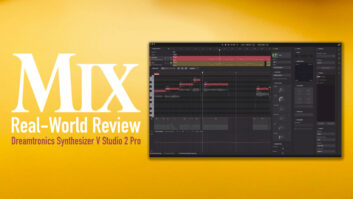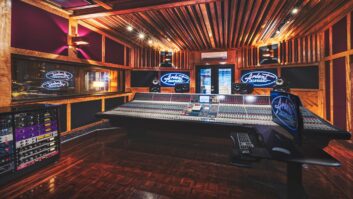Note: This article is a segment of a multi-part series detailing
the history and technology behind some of the industry’s most beloved
and treasured vintage microphones. The autho—the late Stephen
Paul—founded Stephen Paul Audio (www.spaudio.com), a firm that continues to offer
specialized services in the restoration and hot-rodding of classic
microphones. One of Paul’s most enduring contributions to modern
microphone technology was his research and application of ultrathin
diaphragms (sometimes less than a single micron thick), which spawned a
renaissance in the development of improved microphones from companies
worldwide.
First published in 1989, this article series was one of Mix’s
most popular back-issue requests, and 15 years later, we are pleased to
bring this work to a new generation of microphone fans.
Also, as a bonus, brochures of all the microphones in this article
and other classic mics (in .pdf format) are available on this Website.—George Petersen
In Part 1, we started our series with an in-depth look at the famous
Neumann U47, one of the most celebrated of the tube condenser
microphones. We also covered a lot of ground on the operation of
pressure gradient mics in general, and if you missed that
issue…too bad. But serially folks, I am, from this point on,
going to assume that you have at least a rudimentary understanding of
the principles of physics involved in the construction of pressure and
pressure gradient microphones. We also discussed the construction of
the single backplate condenser capsule as made by Neumann since the
late ‘30s. In this installment we will also be calling upon that
knowledge, so sharpen your pencils—there will be a quiz after the
show.
The stars of the show this time around will be the M49 (with a brief
word about the M50), the U67, and its contemporary sister, still in
production after 20 years, the U87.
They say old mics never die, they just get more expensive, but at
least there are pockets of resistance to their demise here and there.
Like in every major studio in the world, and a lot of minor ones, too!
It is a fascinating fact that as microphones get more and more advanced
in their physical construction, the old ones shine more and more in
their very imperfection. We mentioned last months that all mics are
echo chambers to some degree, and there are good ones and there are bad
ones. Well, this fact bears repeating, that’s why I just did.
Keep it in mind as we explore the offerings from Neumann that kept
the recording world simmering through the ’50s and ’60s. In
our final debacle next month, we will look at the heavy-hitters from
AKG that set the tracks of Ampex 300 Series machines on fire during
that same era.
The M49 debuted in 1949 and was an instant success in German
broadcasting. The microphone was designed on contract for the IRT, the
governmental regulating arm of the German broadcast system. The salient
feature of the M49 was that it was the first condenser microphone
capable of remote pattern control, achieved through electronic means.
By varying the rear-diaphragm voltage against the backplate reference,
a full range of patterns, from omni to cardioid to figure-8, was
accomplished. A Dr. Grosskopf held the patent on this method of pattern
selection, and Neumann was contracted to build the resulting
design.
The 49 had several other interesting features, including one of the
first attempts to limit the effect of grille resonance on the response.
Because the grille is slanted and presents a continuously varying
profile to the capsule, there are fewer standing waves generated. It is
also an interesting microphone because it was one of the first to
incorporate a special ultra-miniature triode tube specifically designed
for microphones. This was the MSC2, which was later refined and further
miniaturized before seeing mass production as the AC701. It was a cute
li’l bugger! It was designed to have a long life, low-current
consumption, high-input impedance, and low microphonic and capacitance
characteristics. In fact, this became the only tube permitted in a
microphone that was going to be used on the German airwaves. It became
understandably popular in Europe.
Neumann M49 with grille and with grille removed. The mic uses a miniature triode tube developed specifically for microphone applications.
CORVETTES AND CADILLACS
The M49 used the same capsule as our old friend the 47, and yet,
because of the completely different housing and the triode electronics,
the sound of the mics bears few similarities. Both of them are superb
vocal mics, though neither was designed for the purpose of
close-miking. However, those crazy Americans, with their Corvettes and
their Cadillacs, their loud ways and their rude rock ’n’
roll, discovered the magic of blasting a Neumann at close range, and
thus began a love affair with proximity effect and large-diaphragm
capsules that has endured to this day. One could even say that a love
affair implies romance, and that level of what it is about these magic
microphones that makes us music and engineering types so crazy. We
recognize that sound. And we love it. All the more ’cause those days
are gone. But the mics aren’t. Thank God.
As we have pointed out before, today’s offerings from the
Mighty Manufacturers Over There are light years ahead of these crusty
old dinosaurs in terms of specmanship and thinkology; but the fact is,
for some reason these new starships just can’t seem to shake the
oldies. It’s kind of like having the Red baron on your tail.
Naturally, new classics like the TLM170 and the Sanken CU-44x are bound
to prove themselves over time, and in some arenas they will doubtless
prove superior not only in specifications, but in performance under
certain conditions. However, the pure thrill of belting a ballad into a
47 tube will never die. The 49 is especially good on female vocals. Not
having quite the “nasality” that the 47 is known for, it
has a smoother high-frequency range, and the size of the grille forms a
larger-volume enclosure giving the capsule more breathing room and
contributing to its “openness.” Many female singers,
including Barbra Streisand, use this microphone. It has a way of
rendering the female vocal with an immediacy and presence not found in
any other design. No, this is not a Neumann brochure. The damn thing
works!
GREAT BALLS OF FIRE
Because there was also a demand for a microphone that would compensate
for the loss in high-frequency response incurred by long distances, the
M50 was born. High frequencies roll off as the square of the reciprocal
of the distance from the sound source due to frictional effects. This
means that the viscosity of the air is sufficient to dissipate sound
energy in the form of heat, and as there is less power in the treble
range, it suffers the most from this effect. Therefore, when a mic is
hung high above an orchestra in the auditorium, a boost in the response
above 5 kHz is desirable. Even today, these microphones still make some
of the most wonderful orchestral recordings in the world. We have
successfully modified this model with a one-micron diaphragm and they
sound quite wonderful.
We will touch on them briefly, but as they were omnidirectional only
and not often used on vocals, they are beyond the scope of this
diatribe. Just for the archives, we have included a photograph of one
without its grille, so the vastly different construction (and the
meaning of this subhead) from the 49 can be seen easily. It confuses a
lot of people that these two mics are almost identical on the exterior.
You can tell a 50, as it always has a white jewel or dot on the front,
and the 49 has a red one.
So much for the 49. We now turn to a significantly difficult
microphone to pin down, the famous (or infamous if you prefer) U67.
SO, YOU WANT A CLOSE-UP MIC?
Sometime in the mid-’60s, someone at Neumann had a great
idea—“Hey, let’s build a close-up microphone!
Yeah!” And so, into the pages of history was written the U67. Now
this mic set the stage for Neumann’s entrance into the future. In
fact, an original brochure for this mic proclaimed, “U67, Sound
of Tomorrow!”
In a way, it did turn out to be somewhat prophetic. The U67 was a
real turning point for Neumann and for recording in general. The 67 was
a genuine attempt to create a tube mic that could withstand sufficient
levels to really allow close-miking a voice or loud instrument without
some of the problems that could occur.
First and foremost, the 67 was designed with a low-frequency
roll-off that was always active, a sort of electronic rumble and pop
filter. It also had a high-frequency roll-off built into the amplifier
and a boost built into the capsule. This was a sort of acoustic
pre-emphasis and electronic de-emphasis curve. The idea was that by
using lots of feedback and feedforward, they could control the dynamic
range and signal-to-noise of the mic, enabling it to handle high levels
at close range. (Feedback means taking a portion of the output and
mixing it back into the input out of phase, and feedforward means
mixing it back to the input in phase.) This had the added benefit of
making the mic quieter and less subject to sibilance. However, there
are some who feel that this did not do a w hole lot to make the mic
sound “open,” and the heinous crime of negative feedback is
enough to make today’s audiophiles keel over their Conrad-Johnson
tube amps. Oh well, since when have we pros cared a hoot about wheat
the audiophiles think?
The fact is that there are some who feel that the mic is perfect for
vocals where a smoother sound is desired. We do build a version of the
67 with a one-micron diaphragm and some of this feedforward-back
adjusted for more top end, and it has been used on artists such as
Linda Ronstadt with very satisfying results. The thinner diaphragm
seems to smooth out the peak at 12 kHz sufficiently to allow us to use
that silky energy range with no penalty in signal-to-noise. Be that as
it may, either version of the mic is still widely accepted for its
“warmth.” When we modify it to add clarity, we are careful
to keep this defect intact.
THE LABYRINTH OF THE MINOTAUR
An interesting feature of the 67 is that it was the first
large-diaphragm capsule built by Neumann that used the
“labyrinth” acoustic lowpass filter dual backplate design.
What a mouthful! The photo on page 119 shows the two parts of this
backplate. The electrode is shown with one in a front orientation and
the other showing what the inside facing surface looks like. This
pattern of holes is offset when the capsule is assembled, and no one
hole looks directly into any other hole. They are all spaced apart from
one another about 1.5mm, and the two halves are assembled with a spacer
that creates a slot between them.
What happens here—without getting too technical—is when
a sound wave below about 4 kHz hits one side of the capsule, it goes
through the hole, across the slow and out the other hole. This causes a
time delay, which is adjusted to equal the delay of a wave that went
around the capsule. If they both get there at the same time, they will
cancel, and the mic is a cardioid.
Above 4 kHz, the offset holes act as a lowpass filter and roll off
the sound pressure. The reason this is done is when the wave becomes
smaller than the diameter of the capsule, the physical wall of the
rings and backplates becomes an obstacle to the sound, and the mic
automatically acquires a cardioid characteristic. However, since the
ideal cardioid will pick up all audio frequencies equally up to the
90-degree boundary and then shut everything off as we walk behind the
mic, we have to control the angle of pickup at high frequencies very
carefully. If the mic is designed as a cardioid even at high
frequencies where the wave is shadowed anyway, the mic will attain a
very narrow pickup of high end, considerably less than 90 degrees. By
shutting down the cancellation mechanism at the wavelength/diameter
transition point, the mic is transformed into an omni and picks up high
end quite a bit better off to the side, where it eventually disappears
anyhow owing to the blocking wall of the capsule itself! Get it?
Neither do I, but perhaps if we read it a few times it will come to us.
It is to Neumann’s credit that the U87 is still manufactured, the
solid-state sister to the 67. A modified 87 has the same advantages as
the 67 and the added feature of reliability.
Newer mic designs attempt to address this off-axis problem, and
though they have certainly succeeded, for some strange reason an awful
lot of artists prefer the old chestnuts, which are loaded with flaws. I
guess there’s just something about these poor, old-fashioned,
outmoded designs that people just plain like better! (Well, on some
vocals, anyway.)
Certainly, the cardioid/omni approach is a big, fat compromise at
best, but on the viscerality index, big is beautiful. We like those
32mm diameter mics. The only way to correct the problem is to build a
smaller capsule, and many have been so manufactured. But in the end,
it’s these older, larger, less-perfect systems that have garnered
the huge following of the vocalist crowd. Surely this cannot just be
ignorance on the part of all these artists and producers.
In this series we have tried to get a rare glimpse of the secret
insides of these sensitive devices and explore the subjective aspect of
the almost fanatical devotion that many recordists have to these older
mics. The shapes of the mics themselves have a lot to do with their
responses, and the various types of amplifiers and tubes contribute to
our impressions of them.
We can see that in some cases these devices may be looked at as
“colors” that the engineer can use, as though having a
magic paint box from which to select the perfect “tone” to
capture a sound. When we do a modification to any of these classics, we
are not trying to change the character the mic possesses, but simply
trying to bring the system to the pinnacle of performance that is its
particular shape and hardware underpinnings render it capable of.
In the end, the most successful of us have allowed our ears to be
the judge, and when the artist says “Wow!” you know you got
a good one.
So, until next month, when we delve into the mysteries and some of
the history of the AKG series of classic vocal mics, may all your
vocals be colored and crystalline; yes, and unashamedly so.
Stephen Paul founded Stephen Paul Audio, a Burbank,
Calif.–based firm specializing in the repair, modification and
refurbishing of contemporary and vintage microphones.







